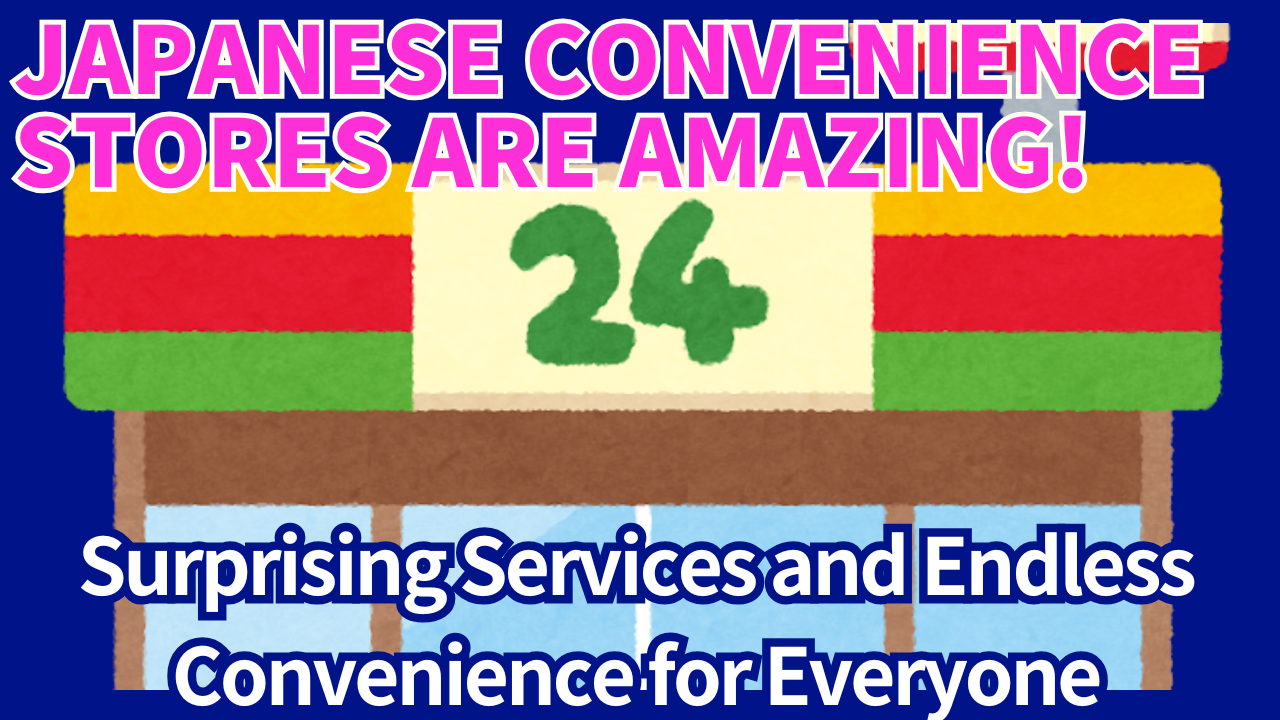- Opening: 24-Hour Lifesavers in Japan
- Tasty and Affordable – The World of Conbini Food
- Daily Necessities and Cosmetics – Everything You Need in One Place
- ATM Access and Bill Payments – Banking Made Easy
- Shipping and Delivery – A Handy Parcel Center
- Tickets and Copy Machines – Surprising In-Store Functions
- Comfortable Store Interiors – Eat-In Space, Clean Facilities, and Safety
- Seasonal and Limited Items – New Surprises All Year Round
- Why Did Conbini Evolve So Far? – A Look at Supermarkets and Department Stores
- Conclusion: Experience Conbini Culture for Yourself
Opening: 24-Hour Lifesavers in Japan
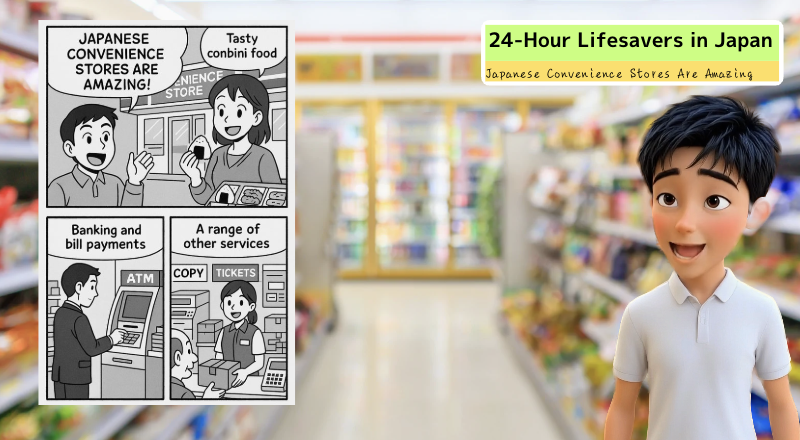
Have you ever found yourself hungry in the middle of the night, suddenly needing a place to get something to eat? Or maybe it started to rain and you didn’t have an umbrella, or you realized you needed to print an important document for the next morning? In Japan, when that sort of unexpected problem pops up, there’s always a place you can turn to: convenience stores, often shortened to “conbini.”
Japanese convenience stores are legendary for their near-24/7 service and an incredible variety of goods and services all under one small roof. For foreign visitors and residents alike, one of the biggest surprises is the sheer range of things you can do at a convenience store: from buying tasty food and snacks to paying bills, picking up concert tickets, shipping packages, and withdrawing cash at an ATM. They are everywhere, always open, and ready to help you tackle just about any need, large or small.
In this video, we’ll explore the extraordinary world of Japanese convenience stores, which go far beyond simply selling drinks and magazines. We’ll discover the extensive lineup of fresh meals, household products, financial services, delivery assistance, and ticket purchasing, and we’ll take a quick look at how these stores evolved into the essential “mini-lifelines” they are today. If you’re living in Japan or just visiting, you won’t want to miss learning about the full potential of these conbini, because they really can make your life here a whole lot easier. Let’s get started!
Tasty and Affordable – The World of Conbini Food
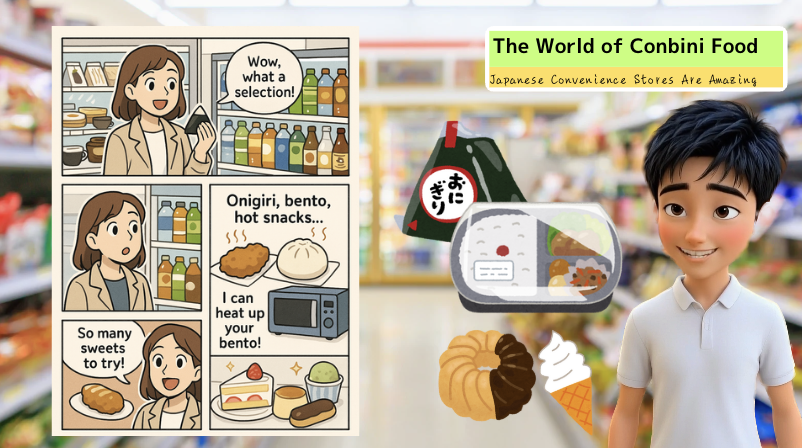
One of the first things that shocks foreign visitors is the quality and variety of food you can find at a Japanese convenience store. You’ll see neatly displayed onigiri rice balls, sandwiches, bento lunch boxes, and even freshly brewed coffee. A quick glance at the refrigerated shelves reveals an enormous selection of drinks—water, tea, juice, soda, beer, sake, and more—all lined up and ready to go 24 hours a day. Unlike some convenience stores overseas, where food might be less appetizing, Japanese conbini food is known for its surprising tastiness.
Onigiri, or rice balls, come in an assortment of flavors: salmon, tuna with mayonnaise, pickled plum, and more. Bento lunch boxes are stocked with various types of rice, pasta, meat, fish, and vegetables. If you feel like something hot, you can grab fried chicken, meat buns, or other hot snacks displayed near the register. The store staff can even heat up your bento for you in a microwave. Many conbini also have coffee machines that offer a freshly brewed cup of coffee for around 100–150 yen, an ideal pick-me-up on a busy morning.
And let’s not forget about desserts and sweets. You can find all sorts of cakes, puddings, and pastries, as well as premium ice cream flavors and innovative seasonal products. Japan celebrates its four seasons in its conbini merchandise, so in the spring you might see sakura-themed sweets, while winter could bring warm soups and hot desserts. Every time you visit, there’s something new to discover, and it’s no exaggeration to say Japanese convenience stores can match specialty shops in both taste and creativity.
Daily Necessities and Cosmetics – Everything You Need in One Place
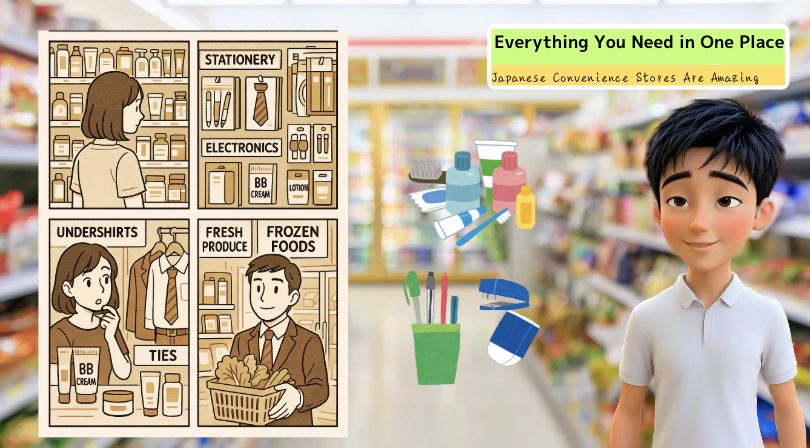
Convenience stores in Japan don’t just specialize in food and drink. They also stock a surprising range of everyday items to help you out in a pinch, whether that’s late at night or during a rushed morning. You’ll find travel-size shampoo, body wash, toothbrushes, and other toiletries alongside medical supplies like bandages, painkillers, and masks. If you need stationery like pens or notebooks—or even charging cables or batteries—you can simply pick them up at a conbini.
Some stores also cater to urgent wardrobe malfunctions by carrying items like stockings, tights, or even undershirts and ties. Women can get quick fixes for cosmetics, such as small bottles of lotion or BB cream, while men sometimes find spare dress shirts if they spilled coffee on their clothes during a busy workday. Increasingly, some stores are expanding into fresh produce or a broader selection of frozen foods, so you can easily stock up on groceries without a special trip to the supermarket.
In short, these stores are your go-to spot whenever you realize you’ve forgotten something, or you don’t have time to head to a bigger store. They are compact but well-stocked lifesavers that let you handle last-minute errands or fill unexpected needs at any time of day.
ATM Access and Bill Payments – Banking Made Easy
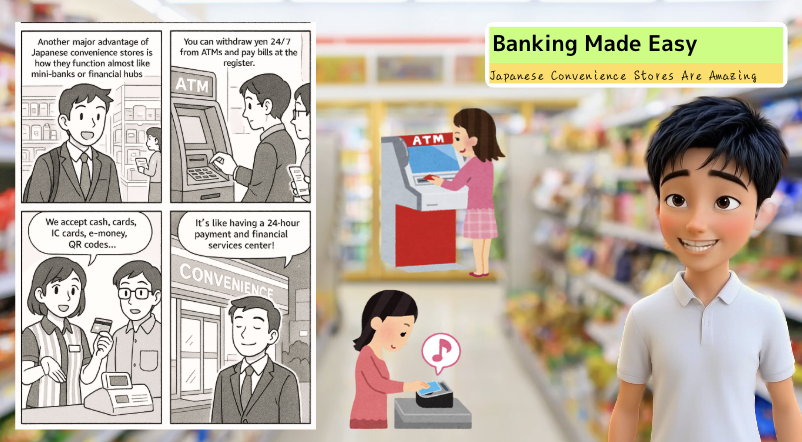
Another major advantage of Japanese convenience stores is how they function almost like mini-banks or financial hubs. Nearly every store has at least one ATM, which usually accepts major domestic cards and often even international cards. This means you can withdraw Japanese yen 24/7, which is a huge relief if you need cash late at night when regular bank branches are closed. In particular, Seven Bank ATMs (found in 7-Eleven stores) are famous for supporting cards from overseas, complete with English-language instructions for stress-free transactions.
But it doesn’t stop at ATM services. You can pay a wide range of bills at the register by simply bringing your invoice with a barcode. That includes utilities like electricity, gas, water, mobile phone bills, even taxes and insurance payments in some cases. It’s incredibly convenient for busy workers who don’t have time to stop by the bank during office hours, and it’s just as convenient for foreign visitors who might need to cover certain fees while in Japan.
Japanese conbini also offer comprehensive payment methods. You can use cash, credit cards, transportation IC cards (like Suica or PASMO), electronic money (like nanaco or WAON), and QR code payment apps (like PayPay and LINE Pay). Big credit card networks like Visa and Mastercard are widely accepted, so travelers don’t need to worry about carrying too much cash around. As a result, it’s not exaggerating to say convenience stores serve as 24-hour payment and financial service centers—right in your neighborhood.
Shipping and Delivery – A Handy Parcel Center

In Japan, convenience stores can also handle deliveries and postal services, which is especially useful if you don’t have time to wait at home for your packages. If you need to send a parcel, you can simply go to a conbini, fill out the required forms, and hand it over to the staff at the counter, no need to head to the post office or wait for the courier at home. They’ll even sell you packaging materials like boxes and envelopes.
Receiving packages is equally easy if you opt for convenience-store pickup at checkout when shopping online. This allows you to drop by your local conbini at any hour to pick up your parcel, skipping the hassle of delivery windows. Some stores have dedicated lockers for contactless parcel pickup, which can be unlocked using a digital code you get via email or SMS. With these kinds of options, travelers can even ship souvenirs home without lugging them around, or residents can pick up their online orders whenever it suits their schedule.
Certain conbini chains accept clothing for dry cleaning too—yet another service you wouldn’t expect from a small retail space. You drop off your items at the counter, they send them out for cleaning, and you come back for them later, saving you a trip to the dry cleaner. In effect, these stores double as tiny postal and logistics hubs, letting you handle shipping, receiving, and even laundry errands without any extra effort.
Tickets and Copy Machines – Surprising In-Store Functions
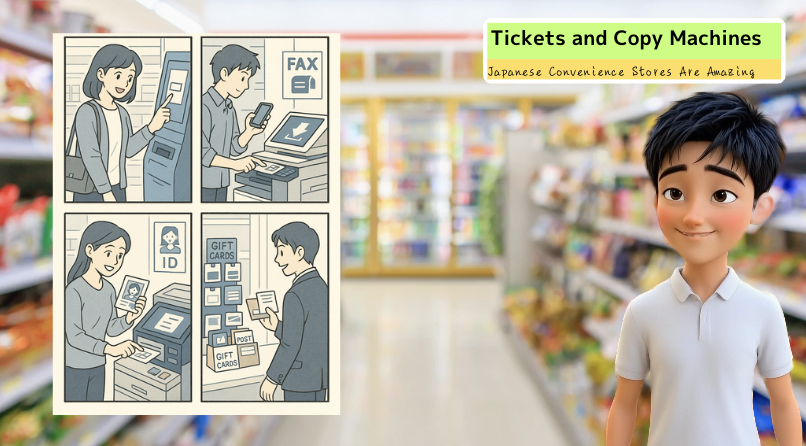
Convenience stores in Japan are also known for their ticket purchasing services. Using the in-store kiosks (like “Loppi” in Lawson or “FamiPort” in FamilyMart), you can buy tickets for concerts, sports events, movie theaters, museums, and even highway buses. Some people queue up late at night to grab tickets for popular concerts the moment they go on sale. Whether it’s paying for tickets you reserved online or directly searching the event on the kiosk, the process is surprisingly simple.
The multi-function copy machines installed in most conbini go far beyond regular photocopies. They can print documents directly from a USB drive or a smartphone, scan documents to PDF, and even send faxes if you need them. Although fax machines might sound old-fashioned, they still pop up in certain parts of Japan. It’s also possible to print out photographs, ID photos, or even official government documents if you have a My Number Card, thanks to e-government initiatives.
Additionally, these machines often let you buy or recharge prepaid cards—such as iTunes gift cards or digital currency for online games—and many conbini also carry postage stamps and postcards, making them your one-stop solution for all sorts of errands. Whether it’s sorting out last-minute travel tickets, printing important files, or purchasing gift cards for a friend, you can get it all done at your neighborhood conbini.
Comfortable Store Interiors – Eat-In Space, Clean Facilities, and Safety

Beyond the array of products and services, Japanese convenience stores are known for being clean, bright, and well-organized, offering a comfortable shopping environment no matter what time of day you visit. Larger stores often include an eat-in corner, furnished with chairs or a small counter, allowing you to enjoy your freshly heated bento or hot coffee right on the spot. It’s a welcome break if you need a quick rest during a busy travel itinerary or a place to check your phone and recharge before your next activity.
Another impressive aspect is the store’s cleanliness. The floors, shelves, and counters are typically spotless, and the staff are known for their polite, efficient service. This can be a pleasant surprise if you’re used to the image of late-night convenience stores abroad that can sometimes feel grimy or even unsafe. In Japan, you can feel secure even if you stop by a conbini alone in the small hours of the night.
Most conbini also provide restrooms for customers, which are regularly cleaned and well-maintained. If you’re ever out and about, in need of a restroom, or have trash to discard, you’ll often find that a convenience store comes to the rescue. It might seem trivial, but being able to relieve yourself or dispose of trash responsibly can be a lifesaver in unfamiliar surroundings.
Finally, the attentive service by conbini staff adds another layer of comfort. They’ll neatly bag your purchases, offer you chopsticks or a spoon for your meals, and hand you napkins or moist towelettes. On rainy days, they’ll check if you need a separate bag to keep your items from getting wet, or even offer to sell you an umbrella if you’re caught unprepared. These small gestures are part of the famous Japanese “omotenashi” hospitality, ensuring a positive experience every time you step into a conbini.
Seasonal and Limited Items – New Surprises All Year Round
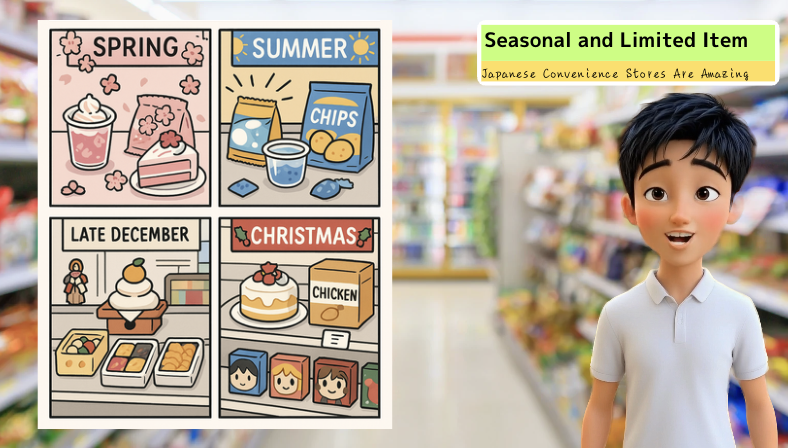
One of the most exciting features of Japanese convenience stores is their constant rotation of seasonal and limited-time products. You’ll see changes according to the seasons, with spring bringing cherry blossom-themed desserts, summer featuring chilled sweets or salty snacks to beat the heat, autumn ushering in pumpkin-flavored treats and Halloween-themed packaging, and winter delivering an assortment of warm comfort foods. The store’s interior signage and decorations change to match the season, giving you a sense of the local culture and festivities.
The stores also adapt to traditional Japanese events throughout the year. In late December, conbini start selling miniature New Year’s decorations, and you might see packs of osechi dishes—a selection of special holiday foods—or mochi for your household altar. Around early February, you’ll notice displays of beans for the Setsubun festival and giant rolled sushi called ehomaki. Toward Christmas, you can reserve a conbini-brand Christmas cake or fried chicken set, often a popular and surprisingly tasty option for people on the go. It might seem odd at first to buy Christmas cake at a convenience store, but the quality can be impressively high and the convenience unbeatable.
Another fun aspect is character or movie tie-ins. You might see famous anime or movie brands featured on packaging, with loyalty programs that let you collect points to redeem exclusive merchandise. Spotting your favorite characters at a conbini can be a delightful surprise, and it’s a great way to bring home a small souvenir of your time in Japan. With all the limited-edition releases and quirky collaborations, it’s safe to say you’ll never get bored exploring what conbini have on offer.
Why Did Conbini Evolve So Far? – A Look at Supermarkets and Department Stores
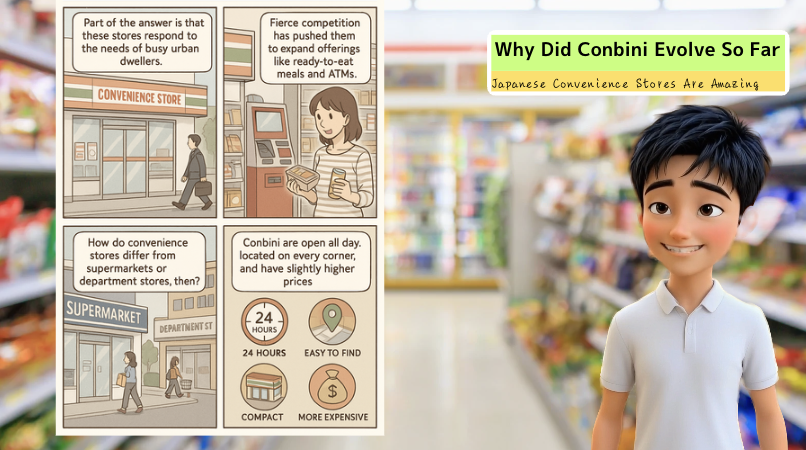
You might be wondering why Japanese convenience stores have developed so many functions and services. Part of the answer is that these stores respond to the needs of busy, modern urban dwellers who want quick, around-the-clock solutions. Since many people work long hours, a store that never closes is an easy fix for late-night hunger pangs or last-minute errands. Conbini started taking root in Japan in the 1970s, and over the decades, fierce competition among major chains—like 7-Eleven, Lawson, and FamilyMart—pushed them to continuously expand their offerings, from bill payments to ATMs and delivery services.
Many Japanese live in relatively small households, sometimes alone, so they appreciate buying food in small quantities without wasting groceries. Convenience stores stepped up by offering an expanding range of ready-to-eat meals and single-serving items. As lifestyles changed, conbini filled the gap between the limited hours of banks and city offices by handling bill payments and other duties. The stores became a second home for essential errands, saving people the trouble of multiple trips to various locations.
How do convenience stores differ from supermarkets or department stores, then? The main distinctions are hours, location, and purpose. Supermarkets typically have large spaces stocked with fresh produce and discounted bulk items, but they often close by late evening. Department stores are even more restricted in operating hours, usually focusing on more upscale products and brand-name items. Meanwhile, conbini are small, easy to find on almost every street corner, and open all day, every day. They may be slightly more expensive than supermarkets on certain items, but the sheer convenience and the fact you can do so many errands at once more than makes up for it.
Thanks to their 24-hour schedule, compact size, and constant focus on improving convenience for customers, these stores have become deeply embedded in Japanese daily life. They’re more than just shops; they’re communal hubs that offer personal touches and helpful services for anyone and everyone.
Conclusion: Experience Conbini Culture for Yourself
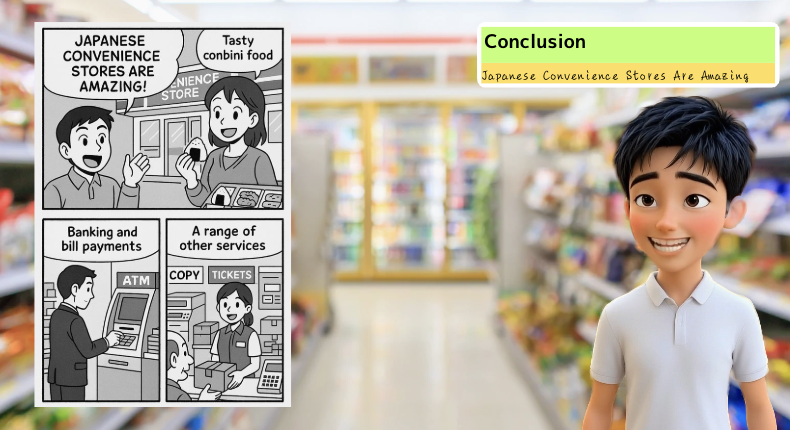
So there you have it—the fascinating world of Japanese convenience stores, where you can eat, pay bills, pick up tickets, ship packages, and more, all in a safe, clean environment that’s open day and night. Whether you’re living in Japan or just passing through, visiting a conbini is one of the easiest ways to feel at home in everyday Japanese life.
It might be a simple convenience store, but once you see the level of service and variety they offer, you’ll understand why so many residents rely on them. Imagine stepping inside when it’s pouring outside, grabbing a hot beverage and an umbrella, and even withdrawing some cash from the ATM while you’re at it—all in a matter of minutes. That’s the magic of conbini.
If you haven’t explored a Japanese convenience store yet, make sure to step in and browse the aisles the next time you pass one. You’re likely to find something you need, something delicious, or something entirely unexpected. And who knows—maybe you’ll walk away with an entertaining story about that time you went to buy a snack and ended up discovering you could pick up bus tickets, pay your bills, and grab a limited-edition anime-themed dessert in the same trip. Thanks for watching, and enjoy your time experiencing the convenience, comfort, and constant surprises that Japan’s conbini culture has to offer.
